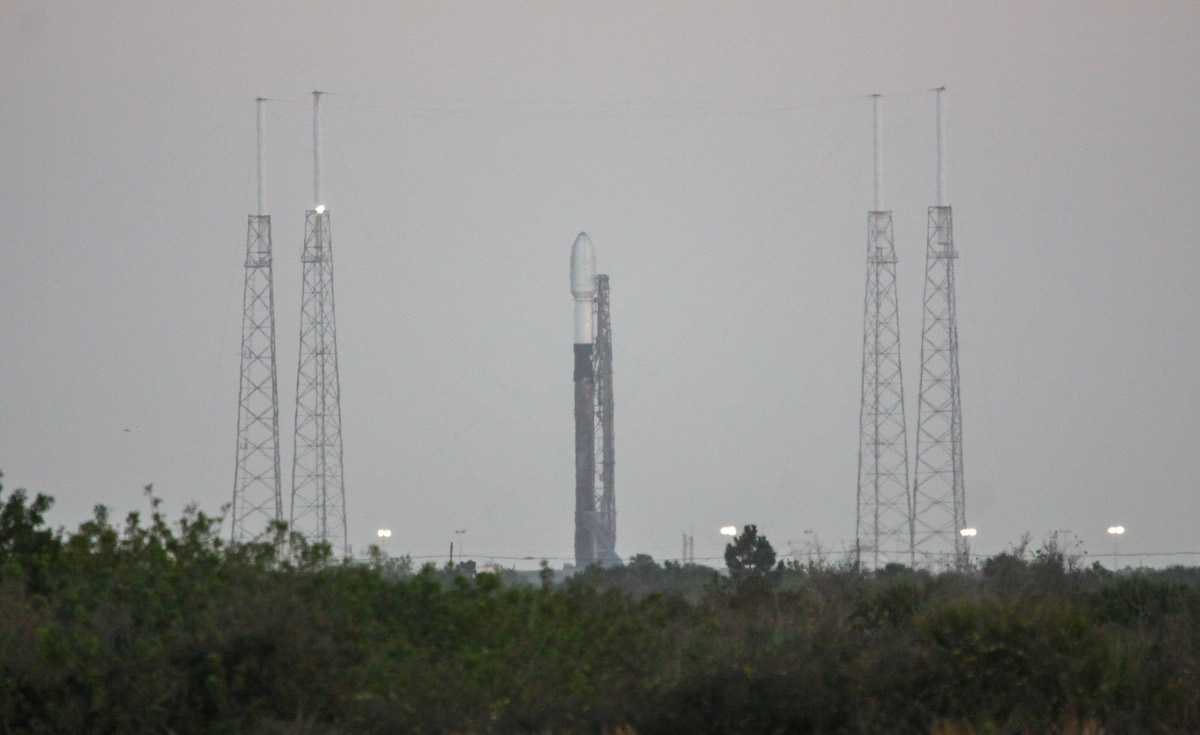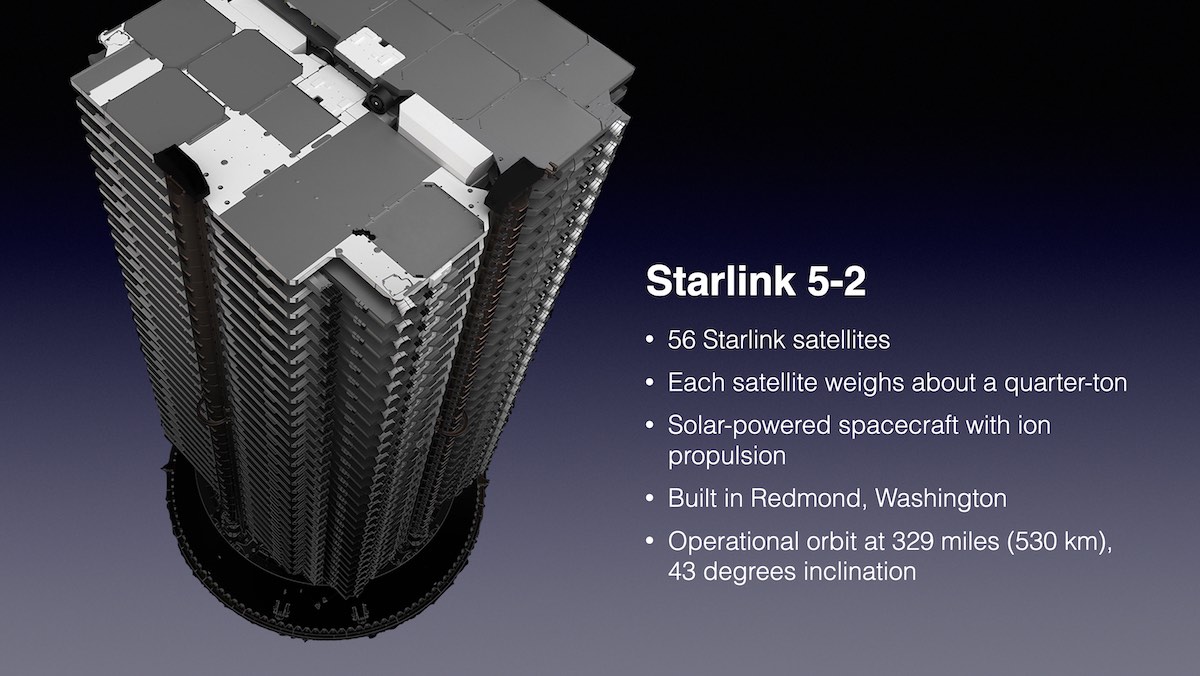Watch our live coverage of the countdown and launch of a SpaceX Falcon 9 rocket on the Starlink 5-2 mission at 4:22 a.m. EST (0922 GMT) on Jan. 26 from Space Launch Complex 40 at Cape Canaveral Space Force Station, Florida. Follow us on Twitter.
SFN Live
Another batch of 56 Starlink satellites will rocket into orbit from Cape Canaveral before dawn Thursday aboard a Falcon 9 launcher, continuing the deployment of SpaceX’s second-generation internet constellation begun last month.
The mission will be the fifth launch by SpaceX so far this year, and the 69th launch launch with a primary purpose of placing Starlink internet satellites into orbit. With the 56 fresh spacecraft set for launch Tuesday, SpaceX will have deployed 3,773 Starlink satellites, with plans to add thousands more in the coming years.
Liftoff of the 229-foot-tall (70-meter) Falcon 9 rocket from pad 40 at Cape Canaveral Space Force Station is set for 4:22 a.m. EST (0922 GMT) Thursday.
Forecasters from the U.S. Space Force’s 45th Weather Squadron predict a 70% chance of good weather for launch, with isolated rain showers and mostly cloudy conditions expected. The primary weather concerns for launch are cumulus clouds and thick clouds, and the risk of lightning.
The 56 Starlink internet satellites mounted on top of the Falcon 9 rocket will head into an orbital plane that is part of SpaceX’s second-generation Starlink net network, called Gen2. The mission is designated Starlink 5-2, and follows the first Starlink launch into the Gen2 network Dec. 28, which carried 54 satellites.
SpaceX plans to eventually launch second-generation Starlink satellites on the company’s new Starship mega-rocket. Those satellites will be larger and more capable than SpaceX’s current fleet of Starlink spacecraft, and will be capable of transmitting signals directly to cell phones. But with the Starship rocket still undergoing preparations for its first orbital test flight, SpaceX officials signaled they will start launching the Gen2 satellites on Falcon 9 rockets.
Elon Musk, SpaceX’s founder and CEO, suggested in August that the company could develop a miniature version of the Gen2 satellites to fit on the Falcon 9 rocket.
The satellites on the first Gen2 launch last month appeared similar, or identical, to Starlink spacecraft SpaceX is already launching to complete its first-generation network, and not the larger Gen2 satellites destined to fly on the huge new Starship rocket, or even the mini Gen2 satellites Musk mentioned last year.

The Federal Communications Commission granted SpaceX approval Dec. 1 to launch up to 7,500 of its planned 29,988-spacecraft Starlink Gen2 constellation. The regulatory agency deferred a decision on the remaining satellites SpaceX proposed for Gen2.
“Under our new license, we are now able to deploy satellites to new orbits that will add even more capacity to the network,” SpaceX wrote on its website before the first Gen2 launch Dec. 28. “Ultimately, this enables us to add more customers and provide faster service – particularly in areas that are currently over-subscribed.”
The FCC previously authorized SpaceX to launch and operate up to 12,000 Starlink satellites, including roughly 4,400 first-generation Ka-band and Ku-band Starlink spacecraft that SpaceX has been launching since 2019. SpaceX also received regulatory approval to launch more than 7,500 Starlink satellites operating in a different V-band frequency.
SpaceX told the FCC earlier this year it planned to consolidate the V-band Starlink fleet into the larger Gen2 constellation.
The Gen2 satellites could improve Starlink coverage over lower latitude regions, and help alleviate pressure on the network from growing consumer uptake. SpaceX said last month the network has more than 1 million active subscribers. The Starlink spacecraft beam broadband internet signals to consumers around the world, connectivity that is now available on all seven continents with testing underway at a research station in Antarctica.
“Our action will allow SpaceX to begin deployment of Gen2 Starlink, which will bring next generation satellite broadband to Americans nationwide, including those living and working in areas traditionally unserved or underserved by terrestrial systems,” the FCC wrote in its Dec. 1 order partially approving the Starlink Gen2 constellation. “Our action also will enable worldwide satellite broadband service, helping to close the digital divide on a global scale.
“At the same time, this limited grant and associated conditions will protect other satellite and terrestrial operators from harmful interference and maintain a safe space environment, promoting competition and protecting spectrum and orbital resources for future use,” the FCC wrote. “We defer action on the remainder of SpaceX’s application at this time.”
Specifically, the FCC granted SpaceX authority to launch the initial block of 7,500 Starlink Gen2 satellites into orbits at 525, 530, and 535 kilometers, with inclinations of 53, 43, and 33 degrees, respectively, using Ku-band and Ka-band frequencies. The FCC deferred a decision on SpaceX’s request to operate Starlink Gen2 satellites in higher and lower orbits.
Like the first Gen2 launch last month, the Starlink 5-2 mission Thursday will target the 530-kilometer-high (329-mile) orbit at an inclination of 43 degrees to the equator.

SpaceX currently has nearly 3,400 functioning Starlink satellites in space, with more than 3,100 operational and roughly 200 moving into their operational orbits, according to a tabulation by Jonathan McDowell, an expert tracker of spaceflight activity and an astronomer at the Harvard-Smithsonian Center for Astrophysics.
The first-generation Starlink network architecture includes satellites flying a few hundred miles up, orbiting at inclinations of 97.6 degrees, 70 degrees, 53.2 degrees, and 53.0 degrees to the equator. Most of SpaceX’s recent Starlink launches have released satellites into Shell 4, at an inclination of 53.2 degrees, after the company largely completed launches into the first 53-degree inclination shell last year.
Shell 5 of the Starlink network was widely believed to be one of the polar-orbiting layers of the constellation, at 97.6 degrees inclination. But the name of the first Gen2 missions — Starlink 5-1 and 5-2 — appear to suggest SpaceX has changed the naming scheme for the Starlink shells.
SpaceX’s launch team will be stationed inside a launch control center just south of Cape Canaveral Space Force Station for Thursday’s predawn countdown. SpaceX will begin loading super-chilled, densified kerosene and liquid oxygen propellants into the Falcon 9 vehicle at T-minus 35 minutes.
Helium pressurant will also flow into the rocket in the last half-hour of the countdown. In the final seven minutes before liftoff, the Falcon 9’s Merlin main engines will be thermally conditioned for flight through a procedure known as “chilldown.” The Falcon 9’s guidance and range safety systems will also be configured for launch.
After liftoff, the Falcon 9 rocket will vector its 1.7 million pounds of thrust — produced by nine Merlin engines — to steer southeast over the Atlantic Ocean. SpaceX has resumed launches this winter using the southeasterly corridor from Cape Canaveral, rather than trajectories to the northeast, to take advantage of better sea conditions for landing of the Falcon 9’s first stage booster.
Throughout the summer and fall, SpaceX launched Starlink missions on paths toward the northeast from Florida’s Space Coast.
The Falcon 9 rocket will exceed the speed of sound in about one minute, then shut down its nine main engines two-and-a-half minutes after liftoff. The booster stage will separate from the Falcon 9’s upper stage, then fire pulses from cold gas control thrusters and extend titanium grid fins to help steer the vehicle back into the atmosphere.
Two braking burns will slow the rocket for landing on the drone ship “Just Read the Instructions” around 410 miles (660 kilometers) downrange approximately nine minutes after liftoff.
The Falcon 9’s reusable payload fairing will jettison during the second stage burn. A recovery ship is also on station in the Atlantic to retrieve the two halves of the nose cone after they splash down under parachutes.
Landing of the first stage on Thursday’s mission will occur just as the Falcon 9’s second stage engine cuts off to deliver the Starlink satellites into orbit. Separation of the 56 Starlink spacecraft, built by SpaceX in Redmond, Washington, from the Falcon 9 rocket is expected nearly 19 minutes after liftoff. SpaceX may have to wait until the rocket passes over a ground station in Guam to confirm Starlink separation from the upper stage.
The Falcon 9’s guidance computer aims to deploy the satellites into an elliptical orbit at an inclination of 43 degrees to the equator, with an altitude ranging between 131 miles and 209 miles (212-by-337 kilometers). After separating from the rocket, the 56 Starlink spacecraft will unfurl solar arrays and run through automated activation steps, then use ion engines to maneuver into their operational orbit.
ROCKET: Falcon 9 (B1067.9)
PAYLOAD: 56 Starlink satellites (Starlink 5-2)
LAUNCH SITE: SLC-40, Cape Canaveral Space Force Station, Florida
LAUNCH DATE: Jan. 26, 2023
LAUNCH TIME: 4:22 a.m. EST (0922 GMT)
WEATHER FORECAST: 70% chance of acceptable weather; Low to moderate risk of upper level winds; Low risk of unfavorable conditions for booster recovery
BOOSTER RECOVERY: “Just Read the Instructions” drone ship northeast of the Bahamas
LAUNCH AZIMUTH: Southeast
TARGET ORBIT: 131 miles by 209 miles (212 kilometers by 337 kilometers), 43.0 degrees inclination
LAUNCH TIMELINE:
- T+00:00: Liftoff
- T+01:12: Maximum aerodynamic pressure (Max-Q)
- T+02:28: First stage main engine cutoff (MECO)
- T+02:31: Stage separation
- T+02:38: Second stage engine ignition
- T+02:42: Fairing jettison
- T+06:42: First stage entry burn ignition (three engines)
- T+07:00: First stage entry burn cutoff
- T+08:23: First stage landing burn ignition (one engine)
- T+08:43: Second stage engine cutoff (SECO 1)
- T+08:44: First stage landing
- T+18:49: Starlink satellite separation
MISSION STATS:
- 199th launch of a Falcon 9 rocket since 2010
- 209th launch of Falcon rocket family since 2006
- 9th launch of Falcon 9 booster B1067
- 171st Falcon 9 launch from Florida’s Space Coast
- 111th Falcon 9 launch from pad 40
- 166th launch overall from pad 40
- 141st flight of a reused Falcon 9 booster
- 69th Falcon 9 launch primarily dedicated to Starlink network
- 5th Falcon 9 launch of 2023
- 6th launch by SpaceX in 2023
- 5th orbital launch attempt based out of Cape Canaveral in 2023
Email the author.
Follow Stephen Clark on Twitter: @StephenClark1.
from Spaceflight Now https://ift.tt/7jkXQ8T
via World Space Info







0 comments:
Post a Comment